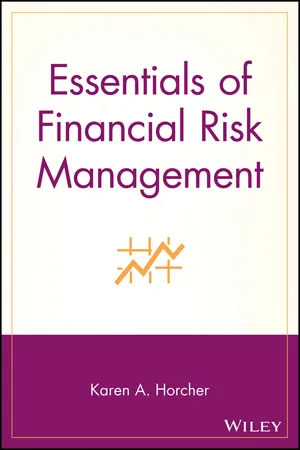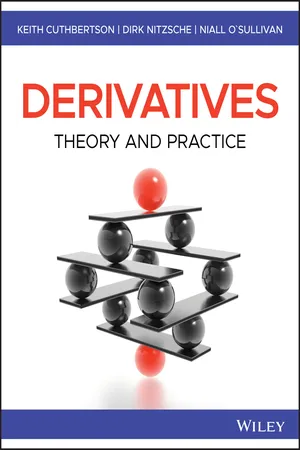Business
Interest Rate Hedge
An interest rate hedge is a financial strategy used by businesses to protect against the risk of interest rate fluctuations. It involves using financial instruments such as interest rate swaps or options to offset potential losses from changes in interest rates. By employing interest rate hedges, businesses can manage their exposure to interest rate movements and stabilize their financial position.
Written by Perlego with AI-assistance
Related key terms
4 Key excerpts on "Interest Rate Hedge"
- Manolis G. Kavussanos, Dimitris A. Tsouknidis, Ilias D. Visvikis(Authors)
- 2021(Publication Date)
- Routledge(Publisher)
1 As a consequence, it is important to use effectively the available financial instruments to manage interest rate risk. These tools are primarily the interest rate derivatives, which provide a relatively cheap and flexible way to manage this type of risk. This chapter showcases their use.For a shipping company to implement a hedging strategy to manage interest rate risk, it needs first to form specific expectations of either a directional movement of interest rates (moving upwards or downwards) or their high/low volatility (fluctuations). Once the management has formed its expectations, it needs to choose the appropriate derivative tools in order to perform its risk management strategy. Interest rate derivatives involve the exchange of cash payments based on changes in market interest rates. Such contracts may be exchange-traded, such as interest rate futures and options on underlying cash instruments (like T-Bonds, T-Notes, T-Bills or Eurodollars) or OTC traded, such as Forward Rate Agreements (FRAs), interest rate swaps and options. For example, an FRA is a forward contract that involves the exchange of cash payments based on changes in the London Interbank Offer Rate (LIBOR) (see Section 12.3 in this chapter). Interest rate swap contracts enable market participants to exchange interest rate payments, i.e. trade a fixed interest rate payment for a floating interest rate payment and vice versa (see Section 12.5 ). Interest rate options require one party to make payments to the other when a stipulated interest rate with a specific maturity, such as for example the three-month LIBOR interest rate, moves outside some predetermined range (see Section 12.6 ).There has been a rapid growth and pace of innovation in the market for interest rate derivatives. The first exchange-traded interest rate futures was introduced in 1975 by the Chicago Board of Trade (CBOT) and the first OTC interest rate swap agreement was introduced in 1981. This impressive growth has been due to volatile interest rates during the 1980s, large amounts of government debt worldwide, huge volumes of capital at risk and the increased interest of businesses to reduce their exposure to interest rate risk. Thus, interest rate swap contracts were soon followed by FRAs, caps, floors, as well as other hybrid instruments, such as forward swaps, options on swaps (swaptions) and even options on options (captions).- eBook - ePub
- Karen A. Horcher(Author)
- 2011(Publication Date)
- Wiley(Publisher)
CHAPTER 3 Interest Rate RiskAfter reading this chapter you will be able to- Identify opportunities to reduce interest rate exposure
- Evaluate ways to manage interest rate risk with forward rate agreements, futures, and swaps
- Assess the use of interest rate options, including swaptions
Although the business of hedging usually involves derivatives, it is possible to rearrange activities to minimize interest rate exposure. Depending on its approach, an organization can supplement internal hedging strategies with interest rate derivatives such as forward rate agreements, futures, swaps, and options.Interest rate derivatives may replace interest rate exposure with exposure to the performance of counterparties and raise other issues. Therefore, it is important to understand credit risk, which is discussed in more detail in Chapter 5.Global Cash NettingWhen an organization has cash flows in multiple currencies, some parts of the organization may have excess cash while others may need to draw down on available lines of credit. A cash forecast for specific currencies will enable surpluses and shortages to be forecast and managed more accurately. On a centralized basis, it may be possible to pool funds from divisions or subsidiaries and make them available to other parts of the organization.Tips & Techniques Exposure ReductionAlthough it might be possible to manage interest rate exposure without derivatives, legal, tax, and regulatory ramifications must be taken into consideration, particularly in foreign countries or for cross-border transactions. These may prohibit such transactions or reduce or eliminate the benefit. The following techniques have been used to reduce interest rate exposure and the resulting need for derivatives: - eBook - ePub
Derivatives
Theory and Practice
- Keith Cuthbertson, Dirk Nitzsche, Niall O'Sullivan(Authors)
- 2019(Publication Date)
- Wiley(Publisher)
CHAPTER 12 Hedging with Interest Rate FuturesAims- To examine how interest rate futures can be used for either hedging the value of fixed income assets (e.g. the dollar value of a portfolio of T-bills), or to ‘lock in’ future borrowing or lending rates (e.g. on existing floating-rate bank loans or deposits).
- To use the ‘price value of a basis point’ (PVBP) and the ‘duration-based hedge ratio’ to determine the optimal number of futures contracts to hedge a cash-market position in a fixed income asset (e.g. T-bills, bank loan, or bank deposit).
- To demonstrate the use of strip, rolling, and stack hedges.
We show how interest rate futures contracts allow investors to hedge spot positions in cash market assets, such as T-bills, bank deposits, and loans. Interest rate futures are a little more complex than futures on, say, stocks or oil. But the key thing to remember is that the price of any interest bearing asset (e.g. spot T-bill prices, interest rate futures prices) always moves in the opposite direction to the change in interest rates (yields). So, for example, when yields fall, the futures price will rise (and vice versa). The futures contracts we consider are the (90-day) T-bill and (90-day) Eurodollar contracts, where the change in futures prices depends on the change in a 90-day (forward) interest rate.Interest rate futures can be used to lock in a known ‘effective’ interest rate over a specific future time period. Consider the following situations:- It is 27 June. You have $10m in a (dollar) bank deposit which pays 180-day LIBOR. The next interest rate reset date is in about 6 months' time on 21 December. You fear a fall in interest rates over the next 6 months which means you will earn less interest on your deposits, when the (180-day) deposit rate is reset on 21 December.You can hedge this risk on 27 June, by going long (i.e. buying) a December-Eurodollar futures contract (which matures a few days after 21 December). If interest rates fall, the December-Eurodollar futures price will rise between June and December. You can then close out (i.e. buy back) your December-futures on 21 December at a higher price, making a cash profit on your futures trades, which can then be used to compensate for the lower interest rate you will receive on your bank deposit (from 21 December over the next 180 days).
- eBook - ePub
Introduction to Financial Mathematics
With Computer Applications
- Donald R. Chambers, Qin Lu(Authors)
- 2021(Publication Date)
- Chapman and Hall/CRC(Publisher)
• tend to have lower transaction costs • tend to have lower margin requirement • tend to be more liquidAssume that a portfolio manager is concerned about interest rate risk in the next six months. The manager can use bond/interest rate futures with six months to settlement to hedge. The portfolio manager can always roll over the hedge if needed as part of a continued hedge. Since the manager cares about the interest rate risk at the end of the maturity of the futures contracts, it is easier to model all durations as of the end of the futures maturity.Consider two portfolios: Portfolio P is a portfolio of bonds with interest rate risk that the portfolio manager wishes to eliminate through hedging for a short period of time. Portfolio F contains short-maturity futures contracts on bonds and will be used to hedge the interest rate risk of Portfolio P for a short period of time. Consider the returns of the bond portfolios represented by durations:where≈ −ΔV pV pD P× Δ yD Pis the duration of the bond portfolio to be hedged at the future’s maturity andV pis the bond value anticipated at the maturity of the futures contract that is to be used as the hedging vehicle. In practice, investors will typically use the bond value today as an approximation.From the math described in a previous section, the number of futures contracts needed is:where≈ −ΔV FV FD F× Δ y ,D Fis the duration of the futures’ underlying asset at the end of futures maturity andV Fis contract price for the bond/interest rate futures contract today.N =(5.37)V p× |D P|V F× |D F|5.6.2.2 Duration-Hedging Bank Loan/deposit Interest Rate Risk Using Bond Futures
Many commercial banks have short-term liabilities (e.g., short-term CDs and deposit accounts) and long-term assets (mortgages and other loans), which leads to a duration mismatch. For a parallel yield shift, Δy, the change in the value of the loan isΔ L ≈ −. The change in the value of deposits isV L×D L× Δ yΔ D ≈ −. In order to hedge the sensitivity of the portfolio to yield changes requiresV D×D D× Δ yV L× |D L| =V D× |D D|
Index pages curate the most relevant extracts from our library of academic textbooks. They’ve been created using an in-house natural language model (NLM), each adding context and meaning to key research topics.



